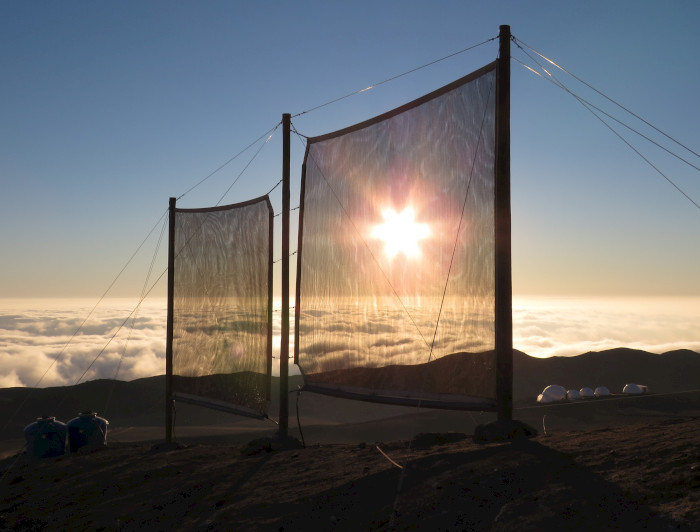Atacama Desert Research Station: A Desert Full of Discoveries
In the world’s driest desert, Universidad Católica has established the country’s first research center focused on the components of this unique ecosystem: the sun, fog, land and vegetation.

photo_camera Scientists have designed “fog-catchers” that collect water in a clean, permanent and sustainable way in the desert. Credit: Pablo Osses
Since the 1980s, researchers at the Institute of Geography have been investigating using fog as a viable source of water. In 1997, they discovered an area 56 km south of the city of Iquique and 7 km north of a small fishing village called Chanavaya in the Tarapacá Region, which made up what we called a fog oasis. The area, which is state-owned, presented valuable features for research in the desert, especially the presence of dense fog, which supports the formation of a unique ecosystem.
In 2007 Universidad Católica obtained the concession of the land from the Ministry of National Assets, and the 1,114 hectares were passed on to the University administration for 25 years, with the objective of environmental conservation as well as the development of research and education into this local phenomenon. Professor Pablo Osses, from the Institute of Geography, coordinates the different activities
carried out there and currently directs the station.
After a decade of operations, the station has an infrastructure that meets its needs: six domes which house bedrooms, bathrooms, storage, teaching and dining areas, as well as an office for administrative and IT work. The installations are self-sufficient, using solar energy and water extracted from fog.
The facilities allow Chilean and foreign scientists to investigate in the desert in excellent conditions. Solar energy research by a team from the Universidad Católica’s Engineering School is just one example of the work undertaken at the station and encompasses research into the sun’s behavior as well as specific issues such as the corrosion of materials used in building photovoltaic plants. This is a particularly significant question, given the energy potential of the Atacama Desert, the driest place on earth and with one of the highest solar radiation levels.
There has also been research on lichens, an ancient form of life. In fact, researchers discovered Santessonia Cervicornis, an endemic species that can only be found in the area around the field station.
Researchers also observe and measure the fog that covers the oasis: it is a cloud that sits over a large part of the southwest Pacific, from central Perú to Pichilemu, a coastal town located in the Sixth Region of the country (35°S). The aim of this research is to verify the effect of climate change on this cloud, as well as the potential of fog as a source of water for human use.
Based on this research, scientists have designed “fog-catchers” that collect water in a clean, permanent and sustainable way, and have exported this technology to countries like Namibia, Yemen, Haiti, Nepal, Perú and Guatemala, among many others.
Researchers at the station will also explore building techniques and the suitability of different materials and how best to use them in these types of environments, in harmony with the location. The research team from the University’s School of Architecture will study the effects of wind, humidity, sand and the sun on the construction of buildings.
Likewise, a team from the School of Engineering will experiment with new materials that could resist these conditions. By becoming a place of research unique in the hyper-arid coastal area, the Atacama Desert Research Station has also undertaken a committed role in educating and maintaining a relationship with neighboring communities.
The small nearby inlets of Chanavaya and Chanavayita provide resources and technical support for the station. Meanwhile, educational work has been geared towards the design and development of guided tours for schools.
To this date, around 500 children from schools in Iquique and other nearby towns have visited the station where they have been able to see the researchers’ work, instruments and routines. Thanks to the guided tours, these children have been able to witness the scientific potential of their land, the driest desert in the world.


